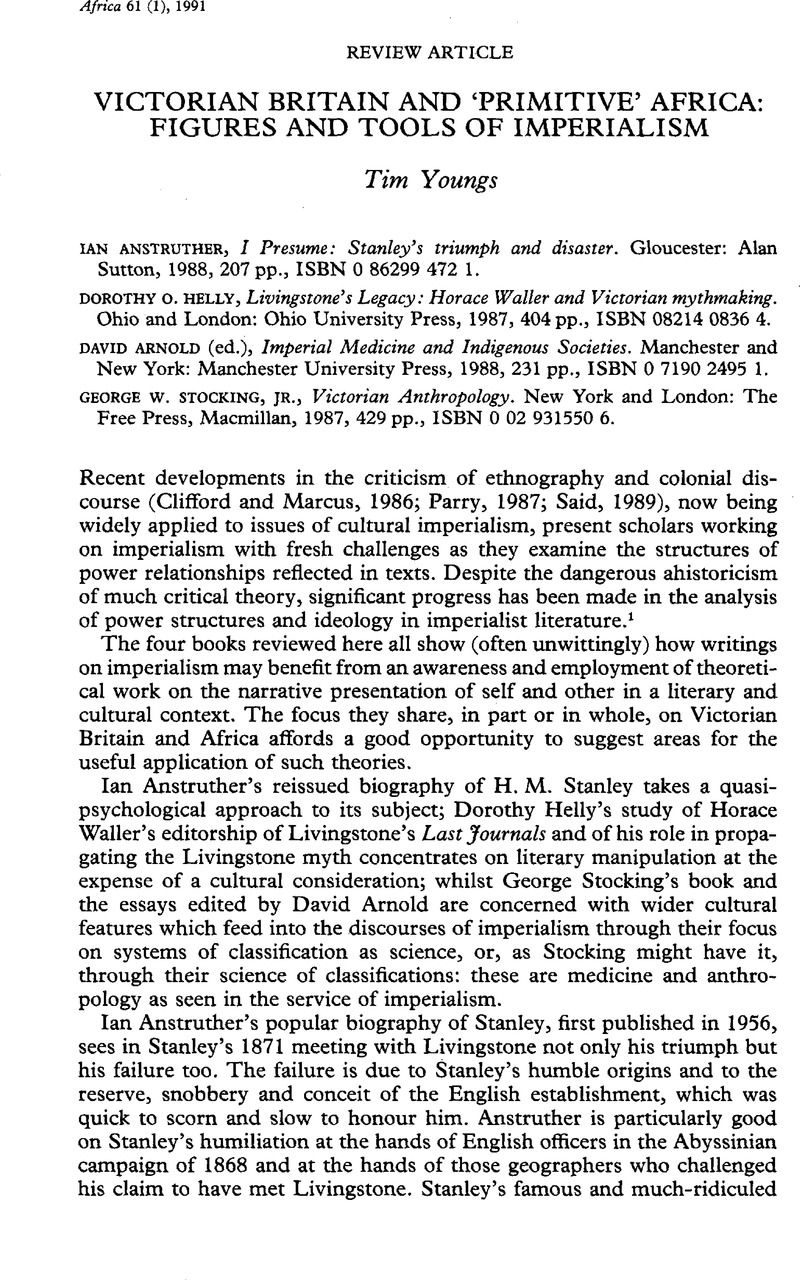No CrossRef data available.
Article contents
Victorian Britain and ‘Primitive’ Africa: Figures and Tools of Imperialism
Published online by Cambridge University Press: 07 December 2011
Abstract
An abstract is not available for this content so a preview has been provided. Please use the Get access link above for information on how to access this content.

- Type
- Review Article
- Information
- Copyright
- Copyright © International African Institute 1991
References
REFERENCES
Berger, M. 1988. ‘Imperialism and sexual exploitation: a response to Ronald Hyam's “Empire and sexual opportunity”’ Journal of Imperial and Commonwealth History 17 (1): 83–9.CrossRefGoogle Scholar
Brantlinger, P. 1988. Rule of Darkness: British literature and imperialism, 1830-1914. Ithaca: Cornell University Press.Google Scholar
Bridges, R. 1982. ‘The historical role of British explorers in East Africa’, Terrae Incognitae 14: 1–21.Google Scholar
Bridges, R. 1987. ‘Nineteenth-century East African travel records: with an appendix on “armchair geographers” and cartography’, Paideuma 33: 179–96.Google Scholar
Clifford, J., and Marcus, G. 1986. Writing Culture: the poetics and politics of ethnography. Berkeley: University of California Press.CrossRefGoogle Scholar
Conrad, J. 1926. ‘Geography and some explorers’ in Last Essays, pp. 1–31. London: Dent.Google Scholar
Fabian, J. 1983. Time and the Other: how anthropology makes its object. New York: Columbia University Press.Google Scholar
Galbraith, J. 1972. Mackinnon and East Africa, 1878-1895: a study in the ‘new imperialism’. Cambridge: Cambridge University Press.Google Scholar
Headrick, D. 1981. The Tools of Empire: technology and European imperialism the nineteenth century. New York: Oxford University Press.Google Scholar
Jones, R. 1972. The Rescue of Etnin Pasha: the story of Henry M. Stanley and the Emin Pasha Relief Expedition. London: History Book Club.Google Scholar
Parry, B. 1987. ‘Problems in current theories of colonial discourse’, Oxford Literary Review 9 (1-2): 27–58.Google Scholar
Said, E. 1989. ‘Representing the colonized: anthropology's interlocutor’, Critical Inquiry 15 (2): 205–25.CrossRefGoogle Scholar
Street, B. 1975. The Savage in Literature: representations of “primitive” society in Englishfiction, 1858-1920. London: Routledge & Kegan Paul.Google Scholar
White, H. 1978. Tropics of Discourse: essays in cultural criticism. Baltimore: Johns Hopkins University Press.Google Scholar
Youngs, T. 1990. ‘“My footsteps on these pages”: the inscription of self and “race” in Stanley's, H. M.How I Found Livingstone’, Prose Studies (forthcoming).Google Scholar
Youngs, T. 1991. ‘The medical officer's diary: travel and travail with the self in Africa’, in Gidley, M. (ed.), Representing Others, University of Exeter (forthcoming).Google Scholar




